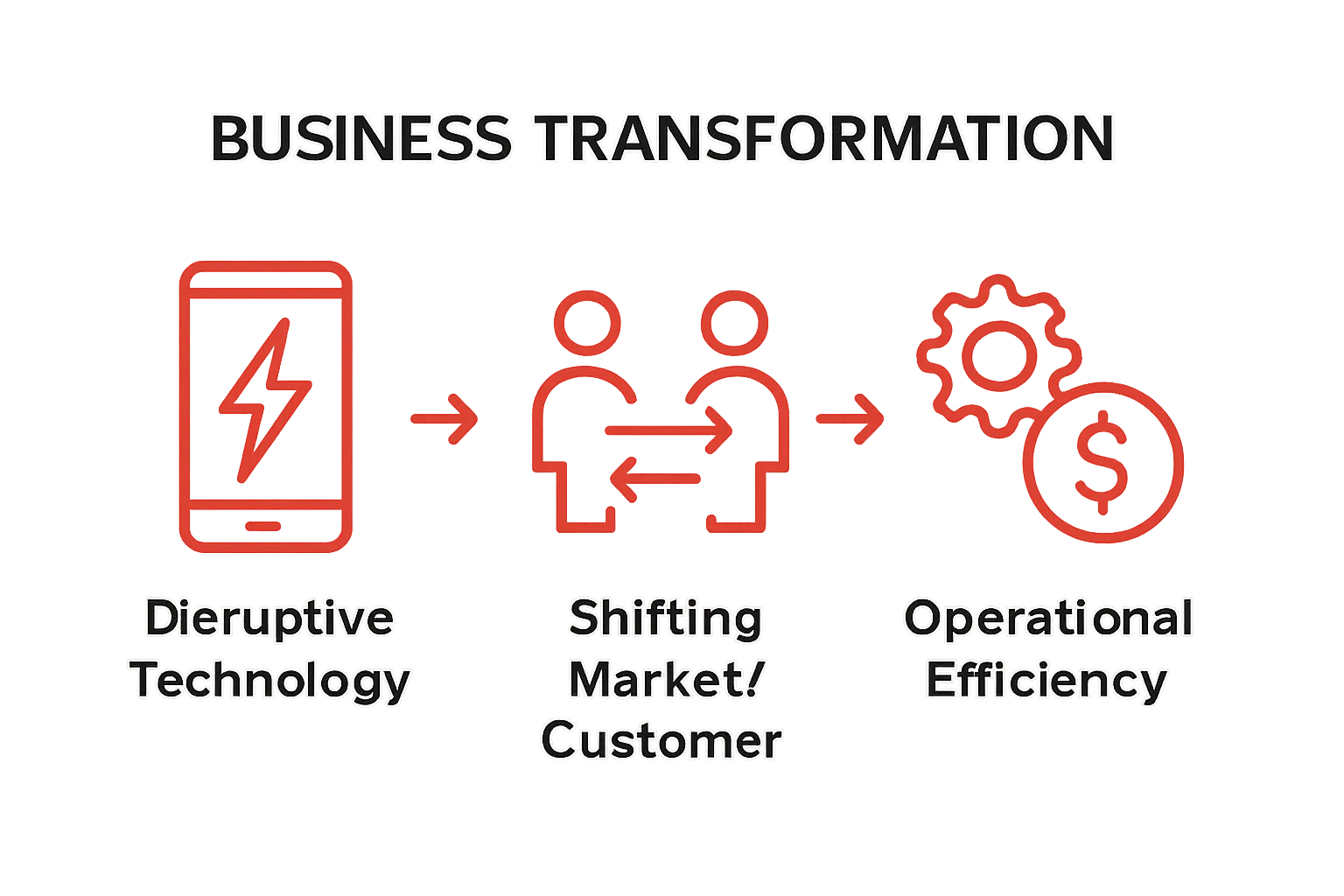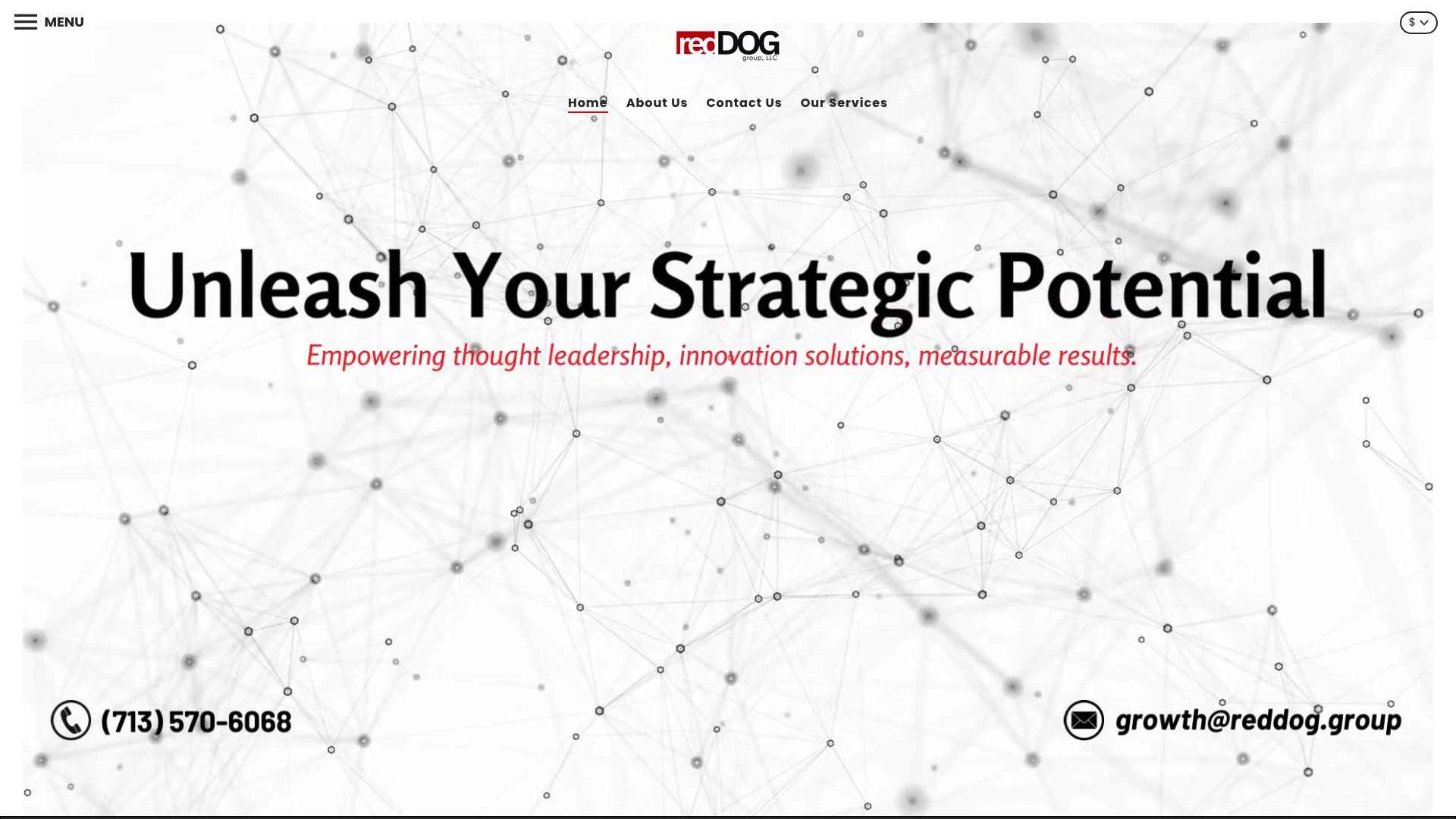
What is Business Transformation? Understanding its Impact
Posted on
Business transformation gets talked about everywhere and for good reason. Companies that get it right can achieve performance gains of up to 30 percent across key metrics according to McKinsey research. It sounds like a mammoth, scary overhaul where everything changes overnight. The surprising fact is that real transformation is less about ripping everything out at once and more about a clear, ongoing shift that rewires how value is created and delivered. That means the biggest winners are not the fastest movers but the ones who rethink the rules and out-adapt the rest.
Table of Contents
- Defining Business Transformation: A Clear Concept
- The Importance Of Business Transformation For Growth
- How Business Transformation Works In Practice
- Key Concepts And Strategies In Business Transformation
- Real-World Examples Of Successful Business Transformation
Quick Summary
| Takeaway | Explanation |
|---|---|
| Business transformation is comprehensive | It requires a holistic approach that integrates people, processes, and technologies for strategic growth. |
| Continuous adaptation is essential | Organizations should view transformation as an ongoing journey rather than a one-time event. |
| Leadership commitment drives success | Strong leadership is crucial to navigate changes and foster a culture that embraces transformation. |
| Strategic alignment is key | Ensure that the operational execution aligns with the organization’s strategic vision for effective transformation. |
| Technological integration is vital | Embrace technological advancements to enhance operational efficiency and market responsiveness for sustainable growth. |
Defining Business Transformation: A Clear Concept
Business transformation represents a comprehensive strategic approach where organizations fundamentally reimagine and restructure their operational models, technologies, processes, and organizational cultures to drive substantial performance improvements and competitive advantage. At its core, business transformation is not merely about incremental changes but represents a holistic, strategic reimagining of how a business creates, delivers, and captures value.
Understanding the Fundamental Nature of Business Transformation
Business transformation goes beyond traditional change management. It involves a profound shift in an organization’s strategic direction, challenging existing paradigms and creating entirely new ways of operating. Our guide on retail digital transformation provides deeper insights into how technological shifts can drive comprehensive organizational change.
The key characteristics of business transformation include:
- Complete alignment between strategic vision and operational execution
- Radical restructuring of internal processes and external engagement models
- Fundamental reimagining of value creation mechanisms
Strategic Drivers of Business Transformation
Multiple critical factors motivate organizations to undergo business transformation. According to McKinsey Global Institute, organizations typically pursue transformation in response to:
Below is a table summarizing the key drivers that motivate organizations to undertake business transformation, organizing the concepts mentioned in the previous section for clearer understanding.
| Strategic Driver | Description |
|---|---|
| Disruptive Technological Innovations | New technology disrupts existing business models, requiring transformative adaptation. |
| Changing Market Dynamics | Shifts in customer expectations and market conditions drive the need for transformation. |
| Competitive Pressures | Increased competition demands that organizations adapt rapidly to maintain their position. |
| Operational Efficiency & Cost Optimization | Seeking ways to streamline operations and reduce costs motivates transformation initiatives. |

- Disruptive technological innovations
- Changing market dynamics and customer expectations
- Competitive pressures requiring rapid adaptation
- Need for operational efficiency and cost optimization
Successful business transformation requires a comprehensive approach that integrates technology, people, processes, and strategic vision. It demands leadership commitment, organizational agility, and a willingness to challenge existing operational paradigms. Organizations must view transformation not as a one-time event but as a continuous journey of strategic adaptation and innovation.
The Importance of Business Transformation for Growth
Business transformation represents a critical strategic imperative for organizations seeking sustainable growth in an increasingly complex and rapidly evolving business environment. By proactively redesigning operational frameworks, companies can unlock unprecedented opportunities for expansion, resilience, and competitive differentiation. Explore our comprehensive business growth strategies guide to understand how strategic transformation drives organizational success.
Driving Economic Performance Through Strategic Transformation
Business transformation directly impacts an organization’s economic performance by creating new value streams and optimizing existing capabilities.
The following table provides a concise overview of how business transformation enhances key dimensions of organizational performance and growth, reinforcing the strategic importance discussed in the surrounding content.
| Performance Dimension | Impact of Business Transformation |
|---|---|
| Operational Efficiency | Streamlines processes, reducing costs and enhancing productivity |
| Revenue Potential | Enables new value streams and accelerates revenue growth |
| Market Responsiveness | Increases organizational agility in responding to market changes |
| Customer Experience Delivery | Improves service quality and customer engagement through innovation |
| Strategic Growth | Supports sustained expansion and long-term competitive differentiation |
- Enhanced operational efficiency
- Increased revenue potential
- Improved market responsiveness
- Superior customer experience delivery
Strategic Growth Enablement
Transformation serves as a powerful mechanism for strategic growth by enabling organizations to:
- Adapt quickly to technological disruptions
- Develop innovative business models
- Create more agile and responsive organizational structures
- Optimize resource allocation and investment strategies
Organizational growth through transformation is not about incremental improvements but fundamental reimagination. Companies that embrace comprehensive transformation strategies position themselves to navigate complex market challenges, capitalize on emerging opportunities, and build long-term competitive advantages. The ability to continuously evolve becomes a critical differentiator in today’s dynamic business landscape, where static approaches quickly become obsolete.

How Business Transformation Works in Practice
Business transformation is a complex, multifaceted process that demands strategic planning, comprehensive analysis, and coordinated execution across organizational domains. Successful implementation requires a systematic approach that integrates technological, cultural, and operational dimensions. Learn how to optimize your small business growth strategy workflow to understand the practical mechanics of strategic change.
Strategic Assessment and Planning
The practical implementation of business transformation begins with a rigorous diagnostic phase. According to CIO Magazine, organizations must conduct a comprehensive evaluation that encompasses several critical elements:
- Detailed analysis of current operational performance
- Identification of strategic gaps and potential improvement opportunities
- Assessment of technological capabilities and limitations
- Evaluation of organizational culture and change readiness
Execution and Implementation Frameworks
Transformation moves beyond theoretical planning through structured implementation strategies.
This table outlines the key phases in the implementation of business transformation, providing a structured view of the sequential steps and their primary objectives as described in the article.
| Phase | Main Activities | Objective |
|---|---|---|
| Assessment & Planning | Analyze current performance, identify gaps, evaluate technology and readiness | Establish a baseline and plan strategic transformation |
| Roadmap Development | Define measurable goals and create detailed transformation roadmap | Provide direction and milestones for change |
| Cross-Functional Execution | Form teams responsible for initiatives, manage change, monitor progress | Ensure coordinated and accountable implementation efforts |
| Continuous Monitoring & Adaptation | Implement feedback mechanisms and adapt strategies as needed | Maintain flexibility and ensure dynamic, responsive change |
-
Developing a clear, measurable transformation roadmap
-
Creating cross-functional teams responsible for specific transformation initiatives
-
Establishing robust change management protocols
-
Implementing continuous monitoring and feedback mechanisms
Practical business transformation is not a linear process but an adaptive, iterative journey. Organizations must remain flexible, consistently reassessing their strategies and being prepared to pivot in response to emerging challenges and opportunities. The most successful transformations integrate technological innovation, human capital development, and strategic vision into a cohesive, dynamic approach that enables sustainable organizational growth and competitive differentiation.
Key Concepts and Strategies in Business Transformation
Business transformation encompasses a sophisticated framework of strategic concepts and approaches that enable organizations to reinvent their operational models and competitive positioning. Understanding these foundational strategies is crucial for successful organizational evolution. Learn more about growth consulting strategies to gain deeper insights into strategic organizational development.
Core Strategic Frameworks
Successful business transformation relies on several interconnected strategic frameworks that guide organizational change. According to Gartner Research, organizations must focus on fundamental strategic pillars:
- Comprehensive digital strategy integration
- Customer-centric value proposition redesign
- Organizational agility and adaptive capabilities
- Technology and human capital alignment
Strategic Implementation Mechanisms
Effective business transformation demands sophisticated implementation strategies that transcend traditional change management approaches. Critical strategic mechanisms include:
- Developing data-driven decision making frameworks
- Creating dynamic organizational learning environments
- Implementing continuous innovation protocols
- Establishing flexible technological infrastructures
Successful transformation strategies recognize that organizational change is a holistic, interconnected process. Modern businesses must view transformation not as a singular event but as an ongoing journey of strategic adaptation. By integrating technological innovation, human capital development, and adaptive strategic thinking, organizations can create resilient, future-ready operational models that continuously evolve in response to complex market dynamics.
Real-World Examples of Successful Business Transformation
Business transformation is not a theoretical concept but a practical strategy that has revolutionized numerous organizations across diverse industries. Successful transformations demonstrate the profound potential of strategic organizational redesign. Explore our comprehensive business growth strategies guide to understand how real-world companies implement transformative approaches.
Technological Reinvention Case Studies
Organizations that successfully navigate technological disruption provide compelling transformation narratives.
VIDEO:video_content] According to [Harvard Business Review, several key industries have demonstrated remarkable transformation capabilities:
- Retail sectors transitioning from physical to omnichannel experiences
- Financial services reimagining customer interactions through digital platforms
- Manufacturing implementing advanced automation and predictive maintenance systems
- Healthcare integrating telemedicine and data-driven diagnostic technologies
Strategic Organizational Metamorphosis
Transformative success extends beyond technological implementation and encompasses holistic organizational redesign. Notable transformation strategies include:
- Restructuring traditional hierarchical management models
- Developing agile, cross-functional collaborative frameworks
- Creating innovation-focused cultural environments
- Implementing continuous learning and adaptation mechanisms
Business transformation represents a dynamic process of continuous strategic reinvention. Organizations that embrace comprehensive transformation strategies position themselves to not just survive but thrive in increasingly complex and competitive business landscapes. By viewing transformation as an ongoing journey of innovation, learning, and adaptation, companies can create resilient, future-ready operational models that consistently deliver exceptional value to stakeholders.
Ready to Transform Your Business for Real Results?
Have you realized that business transformation is not just about a simple change, but a complete reimagining of your business? The article highlighted the struggles companies face when trying to align strategy with execution, the challenge of adapting to fast-changing markets, and the pressure to build operations that keep pace with technology and customer expectations. If your team is feeling stuck or overwhelmed by these pressures, you are not alone. Many small and medium-sized businesses know they need to evolve but get lost on where to begin.

It is time to move from theory to action. Reddog Group specializes in guiding businesses through their most critical transformations. With decades of hands-on experience helping brands achieve measurable growth, our team knows how to build omnichannel strategies that work in today’s marketplace. We understand marketplace management, digital marketing, and seamless integration across retail and online platforms. Learn how to put business transformation into practice and start seeing results by visiting Reddog Group now. If you are ready for a custom plan that unlocks growth and streamlines your operations, connect with our experts today. Make this the moment your transformation becomes real.
Frequently Asked Questions
What is business transformation?
Business transformation is a comprehensive strategic approach that fundamentally reimagines and restructures an organization’s operations, technologies, processes, and cultures to drive performance improvements and create competitive advantages.
What are the key drivers of business transformation?
The main drivers of business transformation include disruptive technological innovations, changing market dynamics, competitive pressures, and the need for operational efficiency and cost optimization.
How does business transformation impact organizational growth?
Business transformation enhances economic performance by creating new value streams, improving operational efficiency, increasing revenue potential, and delivering superior customer experiences, leading to sustainable organizational growth.
What are the steps involved in implementing business transformation?
Implementing business transformation involves a rigorous assessment of current operational performance, identifying strategic gaps, establishing a clear transformation roadmap, creating cross-functional teams, and setting up robust change management protocols.
Leave a comment: